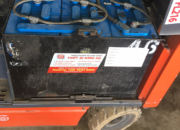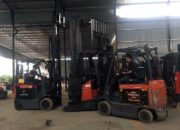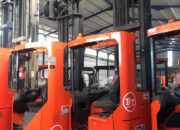Why Modern Logistics Companies Choose Reach Stackers over Traditional Forklifts
Reach Stacker: Driving Performance Breakthroughs for Modern Logistics
In today’s fiercely competitive global logistics landscape, every decision can make the difference between success and stagnation. The mounting pressure of delivery deadlines, warehouse space optimization, and operational cost control weighs heavily on logistics enterprises. Against this backdrop, choosing the right cargo-handling equipment—whether a heavy-duty forklift or a reach stacker—goes beyond simple operations and becomes a strategic decision. This article analyzes why leading logistics companies increasingly favor reach stackers as a comprehensive solution to replace traditional forklifts.
Comparing Reach Stackers vs. Traditional Container Forklifts
To better understand this shift, it is essential to distinguish between the two types of equipment:
Traditional Container Forklift (Heavy-duty Forklift): A well-known machine equipped with forks mounted on a vertical mast that lifts and lowers containers. All lifting, lowering, and moving operations rely on repositioning the entire truck.
Reach Stacker: A hybrid between a forklift and a mobile crane. It features a telescopic boom capable of extending, retracting, and adjusting lifting angles, allowing access to containers at greater heights and depths.
This fundamental difference in mechanism results in significant advantages for reach stackers in modern logistics operations. While forklifts are limited to stacking containers 3–4 tiers high in the first row, a reach stacker can effortlessly stack 5–6 tiers high and reach into the second or third row. This revolutionizes reach, speed, and operational flexibility.
5 Key Reasons Reach Stackers Dominate the Logistics Market
1. Maximizing Every Square Meter of Storage Space
Real estate costs are among the largest expenses for logistics companies. Reach stackers directly address this issue by enabling higher-density storage. With the ability to stack containers up to 6 tiers high and retrieve from the third row, businesses can maximize vertical space and minimize aisle requirements. Unlike forklifts that need wide aisles to access each container row, reach stackers significantly increase yard capacity within the same footprint, directly reducing land leasing or purchasing costs.
2. Lightning-fast Loading and Unloading – Reduced Waiting Time
In logistics, speed is critical. Reach stackers save valuable time thanks to superior handling speed. Instead of constantly repositioning the entire forklift truck, operators can simply park the reach stacker in one spot and extend the boom to pick or place containers. This drastically shortens cycle times, increases cargo throughput at ports and depots, and reduces waiting time for trucks and other equipment. This makes reach stackers the most efficient container handling solution in high-speed environments.
3. Exceptional Flexibility in Any Scenario
Container yards (CYs) and inland container depots (ICDs) often have limited space and dense traffic. Reach stackers excel in maneuverability thanks to a smaller turning radius and the ability to approach containers from multiple angles. They can reach over obstacles or extract containers sandwiched between rows without moving others—an advantage traditional forklifts cannot provide.
4. Enhanced Visibility for Maximum Operator Safety
Workplace safety is paramount. Reach stackers are designed with elevated, often sliding cabins that provide operators with a clear 360° field of view. By contrast, forklift operators’ vision is frequently obstructed by the mast and the container itself. Improved visibility reduces the risk of collisions with personnel, vehicles, and cargo, ensuring a safer and more efficient working environment.
5. More Than Just Containers – A Versatile Investment
The value of a reach stacker extends beyond container handling. Thanks to quick-change attachments, it can be adapted for a wide range of tasks. Companies can equip it with coil clamps, special forks for oversized cargo, or lifting hooks for handling concrete beams, large steel pipes, or industrial equipment. This versatility turns the reach stacker into a smart long-term investment, maximizing utilization and ROI.







